Conductor Caitlin Bailie, who also does a highly entertaining interpretive dance for explaining safety regulations, leads passengers in a toast with the signature Rocky Mountaineer beverage: orange juice and peach bubbly from British Columbia’s Okanagan Valley. All photos: © April Orcutt. All Rights Reserved
Grizzly bears were what I most hoped to see from the Rocky Mountaineer train through Alberta’s rugged Banff National Park. Black bears in glacially-carved valleys or moose or elk along the banks of the Bow River would be great. I had seen osprey and bald eagles as I hiked and canoed in Banff, but now I was on a private train deep in the Canadian Rockies.
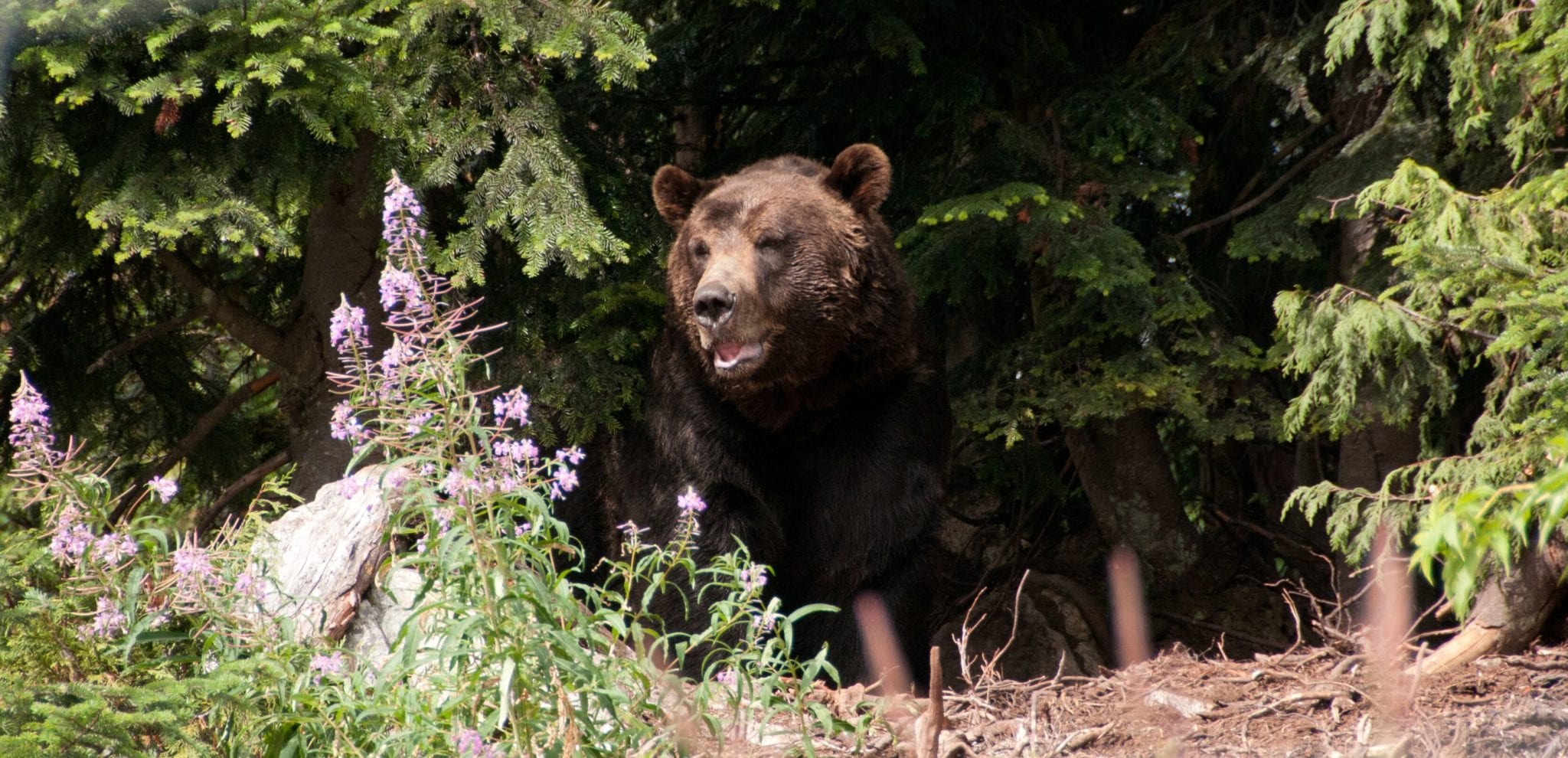
I asked fellow passenger Angela Cook from England why she had signed up for this rail journey.
She said, “I came to see the whales.”
Whales? We were 350 miles from the nearest ocean. I knew the service was supposed to be excellent on this train, but delivering whales to the Rockies was over the top.
Asking a few more questions I learned that half the travelers on this three-day Banff-to-Vancouver-to-Seattle “Coastal Passage” journey combine the trip with a cruise to Alaska. Thus the whale-watching.
Driving Without a Car.
I was traveling on the upscale train through to Seattle and would be running back and forth between the two-story domed view car and the open-platform car to take in the dramatic Canadian-mountain and coastal-Washington scenery. Although the tracks parallel much of the Trans-Canada Highway (Highway 1), going by rail I could focus on the Rockies, rivers, and animals – and not the road. I could take photos without first desperately searching for a safe place to pull the car over.
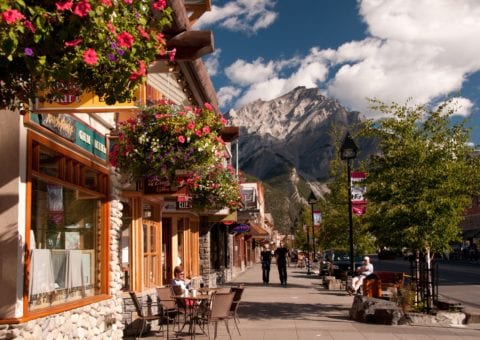
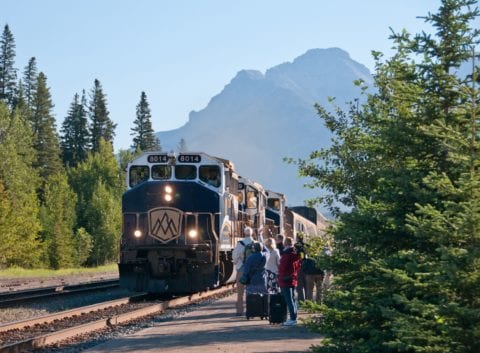
A road trip would not have included the pageantry of starting the trip by walking across a red carpet laid between Canadian and Albertan flags while being greeted by uniformed crew members. The conductor yelled, “All aboard!” The scene made me think I should have been attired in a frilly Victorian dress and traveling with a couple trunks and a hatbox.
Hitting the “Road”
It was hard to leave Banff – the alpine-architecture town was designed with the main street facing steep and craggy Cascade Mountain. But after climbing the spiral stairs to the GoldLeaf-Service domed observation car and contemplating the mountain views from the added height, I was ready to roll. Soon after we headed out, crew members served the signature Rocky Mountaineer beverage: orange juice and peach bubbly from British Columbia’s Okanagan Valley, which we would later pass. We toasted the Canadian Rockies and the journey we were beginning.
Zebulon Fastabend, guest services manager, soon pointed out Castle Mountain on our right. When approaching from the east, it truly looks like a castle, but as we passed its massive southern face, I thought “Fortress Mountain” might have been better. “After World War II, it was going to be renamed Mt. Eisenhower,” Fastabend said, “but then-General Dwight Eisenhower was too busy playing golf to come to the naming ceremony so instead they named a meadow on the side of the mountain ‘Eisenhower Green’ in honor of his love of golf.”
Sitting in the dome car looking up at glacier-crowned Mt. Temple near Lake Louise, I felt like I was riding in a convertible – but without my hair getting tangled or dust blowing into my eyes. And whenever I wanted, I could head downstairs to the open-air platform, where the wind could muss my hair.
Anniversaries and Animals
I overheard English accents behind me mentioning bears. “Did you see a bear?” I asked. Well, they might have seen a sow and cub, but they weren’t sure. Apparently they missed the important Rocky Mountaineer rule of yelling, “Bear on the left!” or “Moose on the right!” They did, however, mention that none of them knew each other before the trip, but all seven couples were celebrating wedding anniversaries from 25 to 51 years. Julie Layton-Hogg (married 30 years to Richard) of Woburn Sands pointed out that together the group had 248 couple-years – or 496 spouse-years – of experience in marriage.
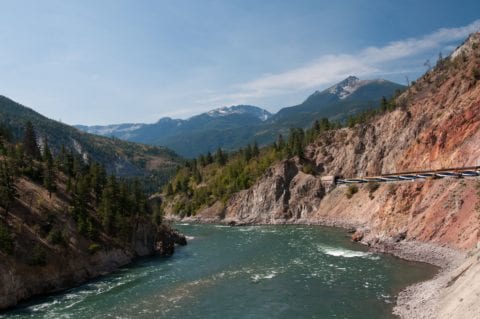
We crossed the Continental Divide in a broad meadow holding half-mile-long Summit Lake. At 5,332 feet in elevation and the highest point on the trip, the Divide separates the Atlantic and Pacific drainages, Alberta and British Columbia, and Banff and Yolo National Parks. We also entered the Columbia River Drainage Basin, which is about the size of France. In 1858 Queen Victoria named British Columbia in honor of the then-British part of the Columbia River’s drainage.
The train began an eight-mile, 1,000-foot descent below Cathedral Crags. Nerds and engineers love the two spiral tunnels which decreased the angle of the tracks (and train speed) and increased safety by looping inside Cathedral Mountain and Mt. Ogden. We entered the canyon of the Kicking Horse River and soon watched people in rafts and kayaks in the water below. A waterfall dropped into Beaver Valley. Alder bushes attract bears, but, alas, not that day. Spruce, fir, cedar and hemlock grew on the mountains while purple, yellow and white wild flowers dotted the open spaces. Ten miles from Rogers Pass in the Selkirk Mountains, the rails run about 500 feet above a river and the Trans-Canada Highway. I couldn’t have had this panoramic view from the road.
Kodak Photo Spots
At historic and scenic points the train slowed from the average speed of 30 mph to “Kodak speed” so passengers could get a good view and take photographs. One such spot was at Craigellachie, where the last spike of the Canadian Pacific Railroad was laid in 1887 – Canada’s version of the U.S.’s Promontory Point in Utah. A crew member said that after the U.S. bought Alaska from Russia in 1867, Canada thought the U.S. might want to annex British Columbia so the country got serious about building a railroad linking Vancouver with the Canadian east. In addition to passenger trains, the lines now carry freight trains with as many as 250 cars stretching two-and-a-half miles.
I asked Carol and Paul Taylor of Shirrell Heath, England, (married 43 years) what they thought of the journey so far. “It’s absolutely marvelous,” Carol said. “The countryside’s so vast – everything’s so big – the mountains, the rivers.”
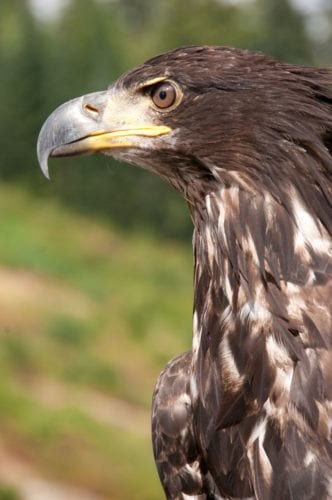
Paul added, “We come from the U.K. where everything’s so compact. If we had these huge long freight trains in England, they’d fall off the edge of the country.”
We eased our way out of the mountains and into hilly B.C. desert. Hoodoos – oddly eroded rock and clay pillars along nearby cliffs – poked out of the landscape. Someone yelled, “Big horn sheep on the right!” where a herd of two dozen grazed, unfazed by our intrusion. Later we saw osprey nests on platforms along the river.
Richard Long of Romsey, England, who’s been married to Stella for 29 years, was on his first trip across the Atlantic. “I was disappointed when we first came out of the mountains,” he said, “but the desert grows on you.
After a Night in Kamloops
We spent the night in the Four Points by Sheraton hotel in Kamloops, a desert town catering to outdoorspeople, and began the next day’s journey with the red carpet and the Canadian and B.C. flags. The train followed the Thompson River, which joined the Fraser River. The Fraser has no dams on its entire 885-mile length and provides spawning habitat for all five types of Pacific salmon species. Around 10 million salmon swim up the Fraser and its tributaries to spawn every year.
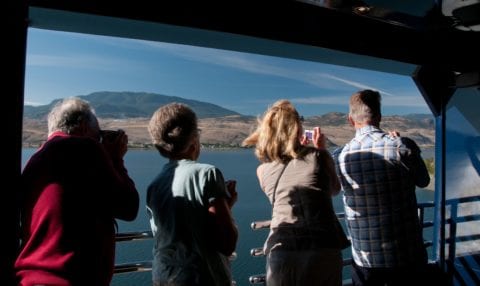
On a car trip, I search for some place to stop for lunch. In the GoldLeaf service of the Rocky Mountaineer, I just moseyed down the spiral staircase and walked 10 feet to the dining room. Salmon was on the menu. So were pork and vegetarian pasta. Meats and vegetables for these meals come from local sources. The yumminess factor of the meals was high, which was impressive given the narrow galley at the end of the dining car. Chef Colin Taylor said, “Our short ribs simply fall apart, just like our local hockey team.” When I asked our waitress, Caitlin Bailie, not to bring me dessert because I couldn’t eat the primary ingredient, she colluded with Chef Taylor to surprise me with a special vanilla-oat cake with vanilla ice cream, strawberries, blueberry compote and a brandy lace cookie.
Abruptly the desert changed to dense temperate rainforest with a proliferation of Western red cedar, hemlock, Douglas fir, cottonwoods, Sitka spruce, and vine and big-leaf maples. When the forests changed to farm land, I could see glacier-covered Mt. Baker, 10,781-feet in elevation and 15 miles south of the border in the state of Washington
Layover Day in Vancouver
Soon the train stopped at the Vancouver station, and a shuttle took me to my hotel, the Fairmont Vancouver. The next morning on my layover day I continued the trip’s themes by walking to Canada Place’s FlyOver Canada, an immersive, hang-glider-like flight simulation over Canada similar to Soarin’ Over the World at Disney’s California Adventure in Anaheim. The eight-minute thrill included swooping down over Castle Mountain in Banff National Park and, from above, seeing the Rocky Mountaineer traveling through the Rockies.
In the afternoon I headed to the Grouse Mountain Reserve for Endangered Animals at the top of the gondola ride at nearby Grouse Mountain ski area to see some of the animals I had missed or only seen from a distance on the train. A golden eagle and a great horned owl posed dramatically before the start of the raptor show, and Coola, a 12-year-old grizzly bear who came to the reserve as an orphaned cub, poked his mighty head out of a heavily wooded area of his enclosure.
South to Seattle
Back on the train the next morning, we rolled south through Washington on long stretches of tracks that ran in places roads did not go. For 17 miles between Bellingham and Samish Bays and nearly 40 miles along Puget Sound from Everett to Seattle, the Rocky Mountaineer ran through forests and tunnels and passed rocky beaches along the water’s edge, giving stunning views unavailable from a car.
The urban world intruded as we approached Seattle. Again I was glad I wasn’t navigating a car through traffic and unfamiliar city streets. I missed the dramatic granite Rockies with their steep faces, the ospreys and eagles swooping down, the big horn sheep and elk and bears that prowled the wilderness. But, now I could look for whales.
For more information: https://www.rockymountaineer.com/
April Orcutt writes for National Geographic Traveler, TravelandLeisure.com, the Los Angeles Times, Dallas Morning News, San Francisco Chronicle & more.